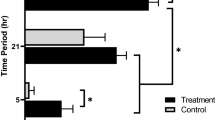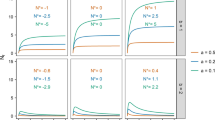Summary
-
1.
Inflorescences of someCurcuma andZingiber (Zingiberaceae) in tropical Asia provide an unique aquatic habitat being discrete, small, and made of numerous smaller compartments (the bracts).
-
2.
The aquatic community in inflorescences ofCurcuma in northern Thailand was composed of immature Diptera, of which the biting midgeDasyhelea and the mosquitoArmigeres theobaldi were the commonest. No important competitors, predators or pathogenic parasites for the mosquito were confirmed.
-
3.
Inter-inflorescence distribution of the mosquito was contagious. Within each inflorescence, the fourth-instar larvae or pupae usually occupied bracts singly.
-
4.
Thek-value analysis detected density-dependent mortality due to contest competition in the mosquito larvae.
-
5.
Variations in the larval and pupal mosquito size were density-independent and remarkably small as compared with size variations known for other mosquitoes.
-
6.
These population attributes (large density-dependent mortality with density-independent, minimally variable individual size) appear unique among mosquitoes, arising from conspecific killing, efficient foraging (inter-bract movement by crawl and single occupation of bracts), and availability of host plant tissues as supplementary food.
-
7.
A simple population model suggested that a small proportion of adult females lay eggs.
Similar content being viewed by others
References
Beaver, R. A. (1983) The communities living inNepenthes pitcher plants: Fauna and food webs. 129–154. InJ. H. Frank andL. P. Lounibos (eds)Phytotelmata: terrestrial plants as hosts of aquatic insect communities. Plexus Publishing, Medford, New Jersey.
Bellows, T. S. (1981) The descriptive properties of some models for density dependence.J. Anim. Ecol. 50: 139–156.
Bliss, C. I. andR. A. Fisher (1953) Fitting the negative binomial distribution to biological data and note on the efficient fitting of the negative binomial.Biometrics 9: 176–200.
Brug, S. L. (1934) Notes on Dutch East-Indian mosquitoes.Bull. Entomol. Res. 25: 501–519.
Chari, M. O. T. (1940)Armigeres theobaldi breeding inCurcuma flowers.J. Malaria Inst. India 3: 263–264.
Carpenter, S. R. (1983) Resource limitation of larval treehole mosquitoes subsisting on beech detritus.Ecology 64: 219–223.
Charlwood, J. D., M. H. Birley, H. Dagoro, R. Paru andP. R. Holmes (1985) Assessing survival rates ofAnopheles farauti (Diptera: Culicidae) from Papua New Guinea.J. Anim. Ecol. 54: 1003–1016.
Cueller, C. B. (1969) A theoretical model of the dynamics of anAnopheles gambiae population under challenge with eggs giving rise to sterile males.Bull. WHO 40: 205–212.
Dye, C. (1984) Models for the population dynamics of the yellow fever mosquito,Aedes aegypti.J. Anim. Ecol. 53: 247–268.
Edman, J. D., L. A. Webber andH. W. Kale (1972) Effects of mosquito density on the interrelationship of host behaviour and mosquito feeding success.Amer. J. Trop. Med. Hyg. 21: 487–491.
Fish, D. (1983) Phytotelmata: Flora and fauna. 1–27. InJ. H. Frank andL. P. Lounibos (eds)Phytotelmata: terrestrial plants as host for aquatic insect communities. Plexus Publishing, Medford, New Jersey.
Fish, D. (1985) An analysis of adult size variation within natural mosquito populations. 419–429. InL. P. Lounibos, J. R. Rey andJ. H. Frank (eds)Ecology of mosquitoes: proceedings of a workshop. Florida Medical Entomology Laboratory, Vero Beach.
Fish, D. andS. R. Carpenter (1982) Leaf litter and larval mosquito dynamics in tree-hole ecosystems.Ecology 63: 283–288.
Fish, D. andD. M. Hall (1978) Succession and stratification of aquatic insects inhabiting the leaves of the insectivorous pitcher plant,Sarracenia purpurea.Amer. Midl. Natur.,99: 172–183.
Gerberg, E. J. (1970) Mannual for mosquito rearing and experimental techniques.Amer. Mosq. Contr. Assoc. Bull. 5.
Hawley, W. A. (1985a) Population dynamics ofAedes sierrensis. 167–184. InL. P. Lounibos, J. R. Rey andJ. H. Frank (eds)Ecology of mosquitoes: proceedings of a workshop. Florida Medical Entomology Laboratory, Vero Beach.
Hawley, W. A. (1985b) The effect of larval density on adult longevity of a mosquito,Aedes sierrensis: Epidemiological consequences.J. Anim. Ecol. 54: 955–964.
Lounibos, L. P. (1979) Temporal and spatial distribution, growth, and predatory behaviour ofToxorhynchites brevipalpis (Diptera, Culicidae) on the Kenya coast.J. Anim. Ecol. 48: 213–236.
Lounibos, L. P. (1983) Behavioral convergences among fruit-husk mosquitoes.Florida Entomologist 66: 32–41.
Lounibos, L. P. (1985) Interactions influencing production of treehole mosquitoes in south Florida. 66–77. InJ. H. Frank andL. P. Lounibos (eds)Phytotelmata: terrestrial plants as hosts for aquatic insect communities. Plexus Publishing, Medford, New Jersey.
Macdonald, W. W. (1960) Malaysian parasites XXXVII. An introduction to the ecology of the mosquitoes of the lowland dipterocarp forest of Selangor, Malaya.Stud. Ins. Med. Res. Malaya 29: 81–109.
Machado-Allison, C. E., D. J. Rodriguez, R. R. Barrera andC. Gomez-Cova (1983) The insect community associated with inflorescences ofHeliconia caribaea Lamarck in Venezuela. 247–270. InJ. H. Frank andL. P. Lounibos (eds)Phytotelmata: terrestrial plants as hosts for aquatic insect communities. Plexus Publishing, Medford, New Jersey.
Mogi, M. (1984) Distribution and overcrowding effects in mosquito larvae (Diptera: Culicidae) inhabiting taro axils in the Ryukyus, Japan.J. Med. Entomol. 21: 63–68.
Mogi, M., M. Horio, I. Miyagi andB. D. Cabrera (1985) Succession, distribution, overcrowding and predation in the aquatic community in aroid axils, with special references to mosquitoes. 95–119. InL. P. Lounibos, J. R. Rey andJ. H. Frank (eds)Ecology of mosquitoes: proceedings of a workshop. Florida Medical Entomology Laboratory, Vero Beach.
Nolan, M. P. andJ. B. Kissan (1985)Ophyra aenescens: a potential bio-control alternative for house fly control in poultry houses.J. Agric. Entomol. 2: 192–195.
Ramalingam, S. (1975) A new species ofTopomyia from Peninsular Malaysia.Mosq. Syst. 7: 185–192.
Seifert, R. P. (1982) NeotropicalHeliconia insect communities.Quart. Rev. Biol. 57: 1–28.
Sheppard, P. M., W. W. Macdonald, R. J. Tonn andB. Grab (1969) The dynamics of an adult populations ofAedes aegypti in relation to dengue haemorrhagic fever in Bangkok.J. Anim. Ecol. 38: 661–702.
Southwood, T. R. E. (1978)Ecological methods with particular reference to the study of insect populations. 2nd edn. Chapman & Hall, London.
Thienemann, A. (1934) Die Tierwelt der tropischen Pflanzengewasser.Archiv Hydrobiol. Suppl. Band 13: 1–91.
Trpis, M. andW. Hausermann (1986) Dispersal and other population parameters ofAedes aegypti in an African village and their possible significance in epidemiology of vector-borne diseases.Amer. J. Trop. Med. Hyg. 35: 1263–1279.
Varley, G. C. andG. R. Gradwell (1960) Key factors in population studies.J. Anim. Ecol. 29: 399–401.
Varley, G. C., Gradwell, G. R. andHassell, M. P. (1973)Insect population ecology. Blackwell, Oxford.
Waage, J. K. andJ. Nondo (1982) Host behavior and mosquito feeding success: an experimental study.Trans. Royal Soc. Trop. Med. Hyg. 76: 119–122.
Walker, E. D., R. S. Copeland, S. L. Paulson andL. E. Munstermann (1987) Adult survivorship, population density, and body size in sympatric populations ofAedes triseriatus andAedes hendersoni (Diptera: Culicidae).J. Med. Entomol. 24: 485–493.
Author information
Authors and Affiliations
Rights and permissions
About this article
Cite this article
Mogi, M., Yamamura, N. Population regulation of a mosquitoArmigeres theobaldi with description of the animal fauna in zingiberaceous inflorescences. Res Popul Ecol 30, 251–265 (1988). https://doi.org/10.1007/BF02513248
Issue Date:
DOI: https://doi.org/10.1007/BF02513248




